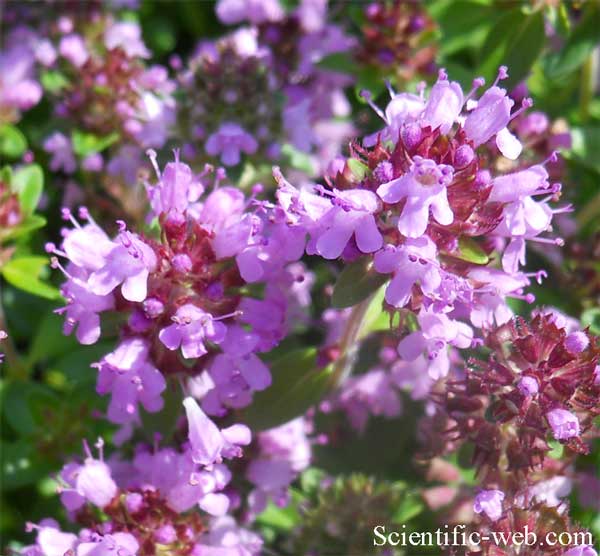
Thymus pulegioides , Photo: Michael Lahanas
Classification System: APG IV
Superregnum: Eukaryota
Regnum: Plantae
Cladus: Angiosperms
Cladus: Eudicots
Cladus: Core eudicots
Cladus: Asterids
Cladus: Lamiids
Ordo: Lamiales
Familia: Lamiaceae
Subfamilia: Nepetoideae
Tribus: Mentheae
Subtribus: Menthinae
Genus: Thymus
Sectio: T. sect. Thymus
Subsectio: T. subsect. Thymus
Species: Thymus vulgaris
Subspecies: T. v. subsp. aestivus – T. v. subsp. mansanetianus – T. v. subsp. vulgaris
Name
Thymus vulgaris L. Sp. Pl. 1: 591. 1753.
Synonyms
Homotypic
Origanum thymus Kuntze, Revis. Gen. Pl. 2: 528. 1891.
Thymus collinus Salisb., Prodr. Stirp. Chap. Allerton: 86. 1796, nom. superfl.
Hybrids
T. × ahimae – T. × aitanae – T. × armuniae – T. × barrelieri – T. × citriodorus – T. × josephi-angeli – T. × lainzii – T. × monrealensis – T. × moralesii – T. × oriolalus – T. × rubioi – T. × viteki
References
Govaerts, R. et al. 2015. Thymus vulgaris in World Checklist of Selected Plant Families. The Board of Trustees of the Royal Botanic Gardens, Kew. Published on the internet. Accessed: 2015 Sep 27. Reference page.
Linnaeus, C. 1753. Species Plantarum 1: 591.
USDA, ARS, Germplasm Resources Information Network. Thymus vulgaris in the Germplasm Resources Information Network (GRIN), U.S. Department of Agriculture Agricultural Research Service.
Vernacular names
беларуская: Чабор звычайны
català: Farigola, Tomell
čeština: tymián obecný
dansk: Have-Timian
Deutsch: Echter Thymian
Ελληνικά: Θυμάρι
English: garden thyme
español: tomillo limonero
eesti: Aed-liivatee
euskara: Ezkai
suomi: Timjami, tarha-ajuruoho
français: Thym commun
hrvatski: Vrtni timijan
Kreyòl ayisyen: Ten
magyar: kerti kakukkfű
lietuvių: Vaistinis čiobrelis
latviešu: Timiāns
Mirandés: Tomilho salseiro
Nederlands: Echte tijm
polski: macierzanka tymianek
português: Tomilho
română: Cimbru de câmp
русский: Тимьян обыкновенный
slovenčina: dúška tymianová
svenska: Kryddtimjan
Thymus vulgaris (common thyme, German thyme,[1] garden thyme[2] or just thyme) is a species of flowering plant in the mint family Lamiaceae, native to southern Europe from the western Mediterranean to southern Italy. Growing to 15–30 cm (6–12 in) tall by 40 cm (16 in) wide, it is a bushy, woody-based evergreen subshrub with small, highly aromatic, grey-green leaves and clusters of purple or pink flowers in early summer.[3]
It is useful in the garden as groundcover, where it can be short-lived, but is easily propagated from cuttings.[3] It is also the main source of thyme as an ingredient in cooking and as an herbal medicine. It is slightly spicier than oregano and sweeter than sage.
A shoot of a common thyme plant in the wild (Castelltallat)
The Latin specific epithet vulgaris means “common” in the sense of “widespread”.[4]
Cultivars
Numerous cultivars and hybrids have been developed for ornamental purposes. Nomenclature can be very confusing.[5] French, German and English varieties vary by leaf shape and colour and essential oils.[6] The many cultivars include 'Argenteus' (silver thyme).[7]
The cultivar 'Silver Queen', with white-margined leaves, has gained the Royal Horticultural Society's Award of Garden Merit.[8][9]
See also
Thyme (discussion of culinary and medicinal uses)
Thymol, a disinfectant extract of essential oils
References
"Bonnie Plants Thyme". Retrieved January 10, 2015.
"Thymus vulgaris". Natural Resources Conservation Service PLANTS Database. USDA. Retrieved 10 December 2015.
RHS A-Z encyclopedia of garden plants. United Kingdom: Dorling Kindersley. 2008. p. 1136. ISBN 978-1405332965.
Harrison, Lorraine (2012). RHS Latin for Gardeners. United Kingdom: Mitchell Beazley. ISBN 978-1845337315.
Totally Thyme
Herbs 2000: Thymus vulgaris
Thymus argenteus
"RHS Plant Selector - Thymus 'Silver Queen'". RHS. Retrieved 5 March 2021.
"AGM Plants - Ornamental" (PDF). Royal Horticultural Society. July 2017. p. 102. Retrieved 23 December 2018.
Bibliography
L. H. Bailey; Manual of Cultivated Plants.
M. Easter; International Thymus Register and Checklist.
Thymus pulegioides, common names broad-leaved thyme or lemon thyme,[1] is a species of flowering plant in the family Lamiaceae, native to Europe. Growing to 5–25 cm (2–10 in) tall by 25 cm (10 in) wide, it is a small spreading subshrub with strongly aromatic leaves, and lilac pink flowers in early summer.[2] The specific epithet pulegioides highlights its similarity to another species within Lamiaceae, Mentha pulegium (pennyroyal).[3]
Description
Broad-leaved thyme is a creeping dwarf evergreen shrub with woody stems and a taproot. It is rather similar to wild thyme (Thymus serpyllum) but it is larger, the leaves are wider and all the stems form flowering shoots. The reddish stems are squarish in cross-section and have hairs on the edges. The leaves are in opposite pairs with short stalks, and the linear ovate blades have tapering bases and untoothed margins. The plant flowers in July and August. The usually pink or mauve flowers form rounded umbels and each has a tube-like calyx and an irregular straight-tubed, hairy corolla. The upper petal is notched and the lower one is larger than the two lateral petals and has three flattened lobes which form a lip. Each flower has four projecting stamens and two fused carpels. The fruit is a dry, four-chambered schizocarp.[4]
Distribution and habitat
Broad-leaved thyme is native to temperate parts of Europe. It grows in rough places on light, sparse soils. These include hills, rocky outcrops, gravels, sandy places, wasteground and roadsides.[4]
Cultivation
Suitable for cultivation in any well-drained alkaline or neutral soil in full sun, this ornamental thyme is useful as groundcover, but can also be used like thyme in cooking. Numerous cultivars have been selected, of which 'Aureus',[5] with lemon-scented gold leaves, and 'Bertram Anderson'[6] have both gained the Royal Horticultural Society's Award of Garden Merit.[7]
References
"Plants for a future - Thymus pulegioides". Retrieved 6 June 2013.
RHS A-Z encyclopedia of garden plants. United Kingdom: Dorling Kindersley. 2008. p. 1136. ISBN 978-1405332965.
Harrison, Lorraine (2012). RHS Latin for gardeners. United Kingdom: Mitchell Beazley. p. 224. ISBN 9781845337315.
"Broad-leaved Thyme: Thymus pulegioides". NatureGate. Retrieved 2013-12-13.
"Thymus pulegioides 'Aureus'". RHS. Retrieved 16 February 2020.
"Thymus pulegioides 'Bertram Anderson'". RHS. Retrieved 16 February 2020.
"AGM Plants - Ornamental" (PDF). Royal Horticultural Society. July 2017. p. 102. Retrieved 23 December 2018.
Retrieved from "http://en.wikipedia.org/"
All text is available under the terms of the GNU Free Documentation License

